Abstract
Intense interest in the experimental analysis of nonhuman short-term memory was occasioned by the “cognitive revolution” in the early 1970s. As researchers tested and refined their theoretical models, a sizable empirical literature on the subject rapidly emerged. Generally missing from that literature, however, is an integrated account of the empirical laws of delayed stimulus control. In its absence, cognitive theories have grown increasingly complex and their connection to established principles of learning more remote. The present article reviews a representative segment of the nonhuman memory literature in an effort to identify and tentatively quantify empirical laws that may underlie some of the major findings. Specifically, a delay-reduction principle adapted from the conditioned reinforcement literature and a proposed principle of serial stimulus compounds were evaluated against data from delayed matching to sample, serial probe recognition, differential outcome, directed forgetting, and surprisingness preparations. Although by no means offering a complete description of the data, the proposed analysis organizes an apparently disparate collection of empirical results and suggests several new lines of inquiry into the subject.
Keywords: short-term memory, delayed stimulus control, delayed matching to sample, choice, conditioned reinforcement, animal cognition, serial probe recognition, directed forgetting, delay reduction
Full text
PDF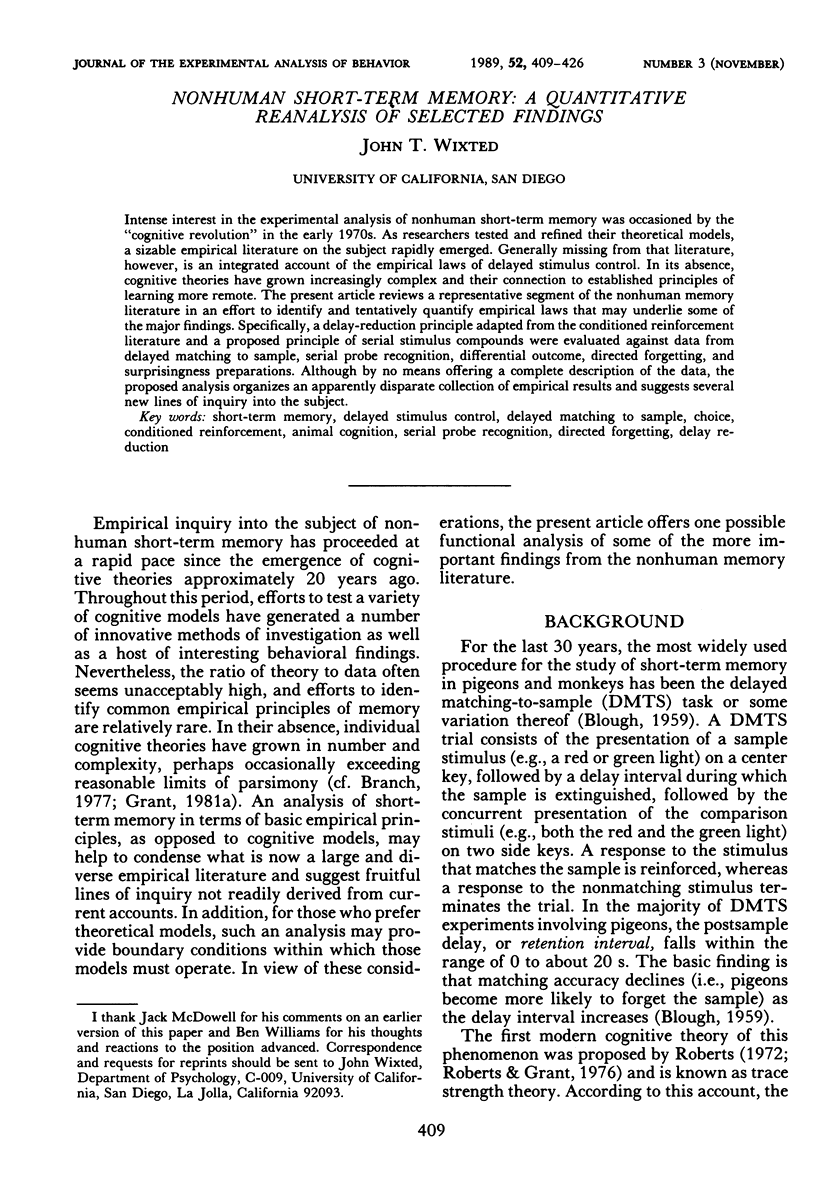

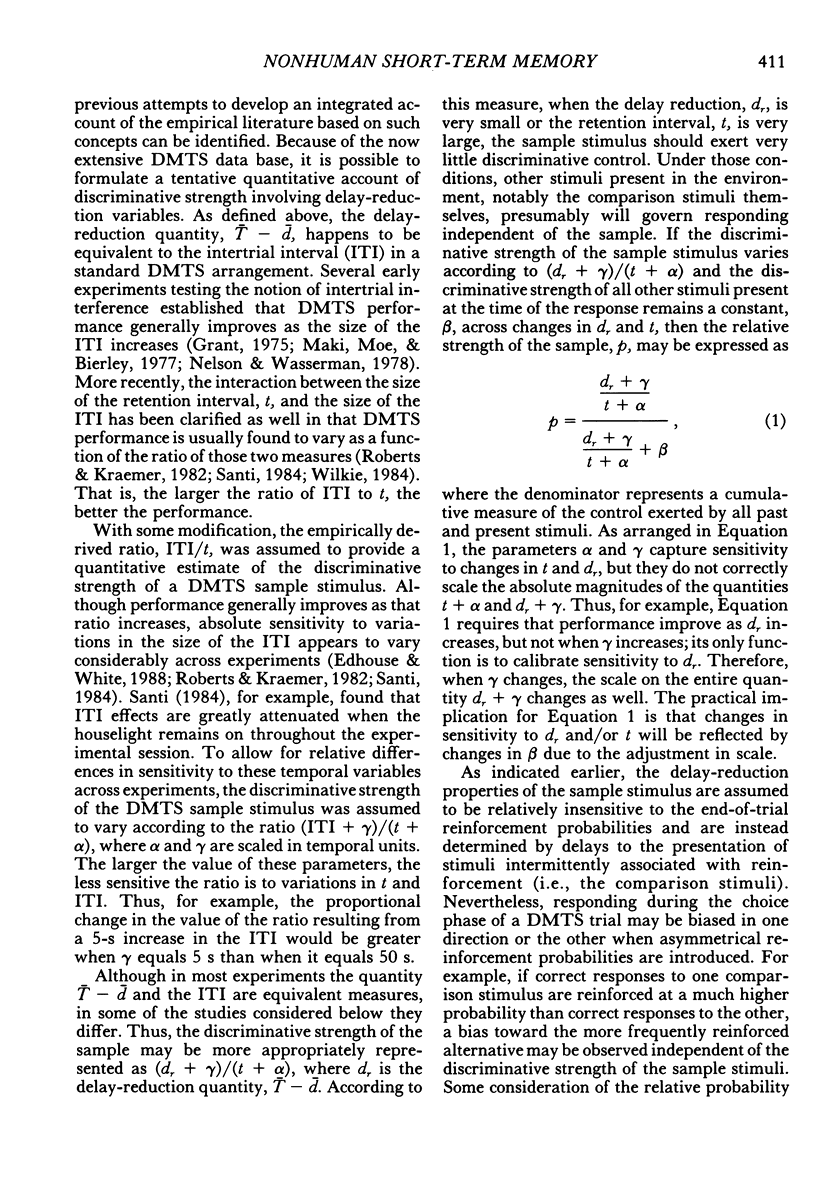
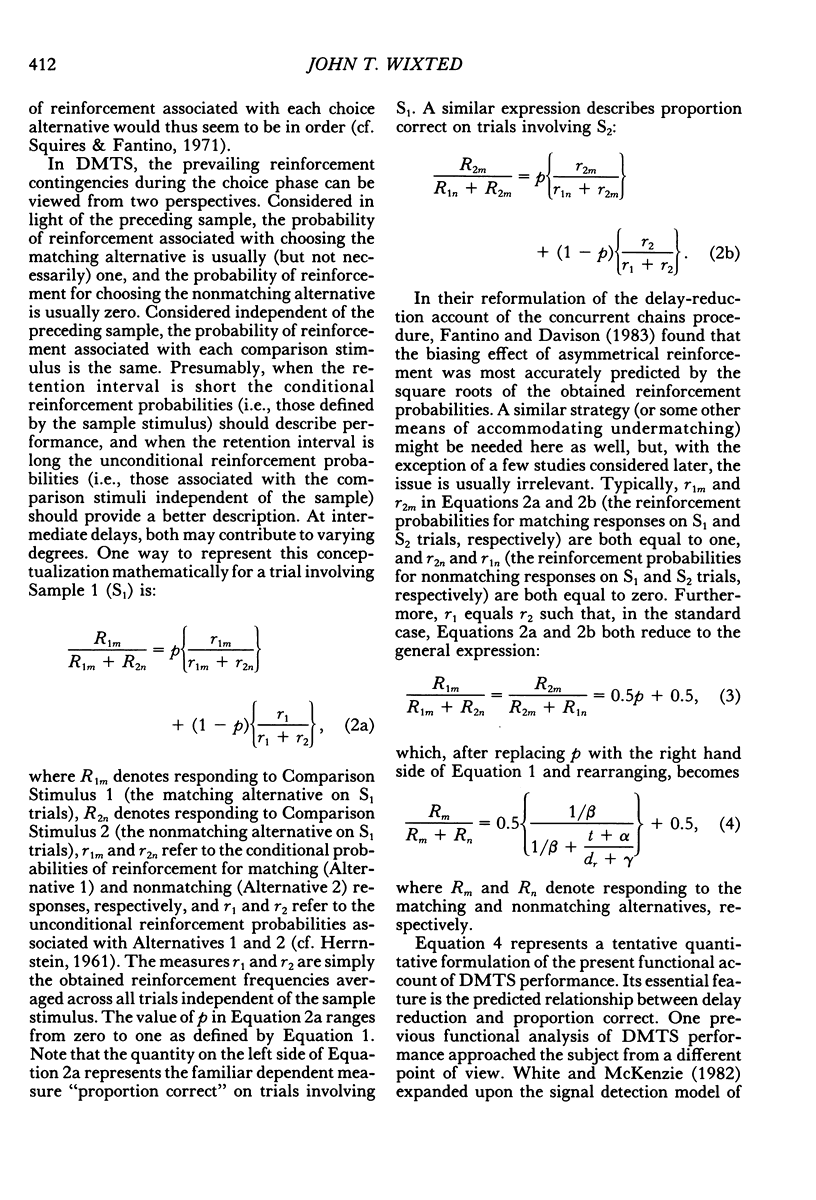


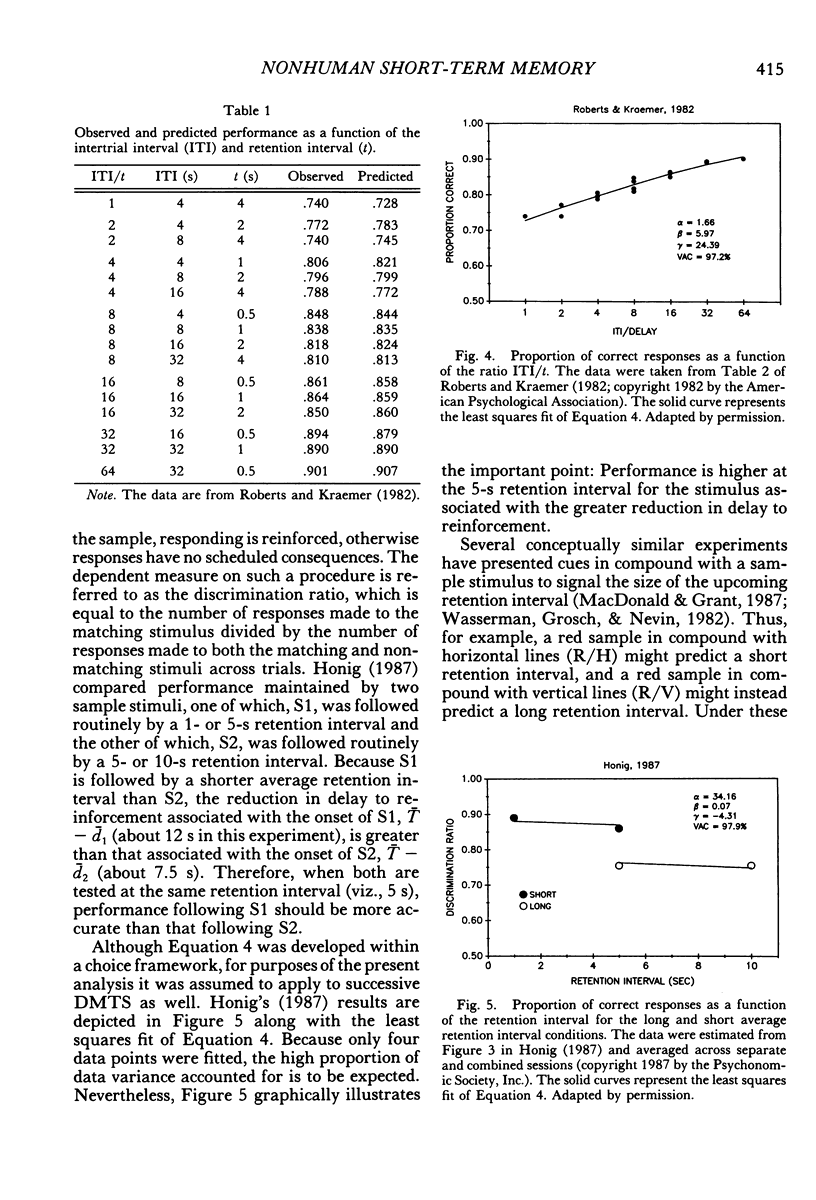


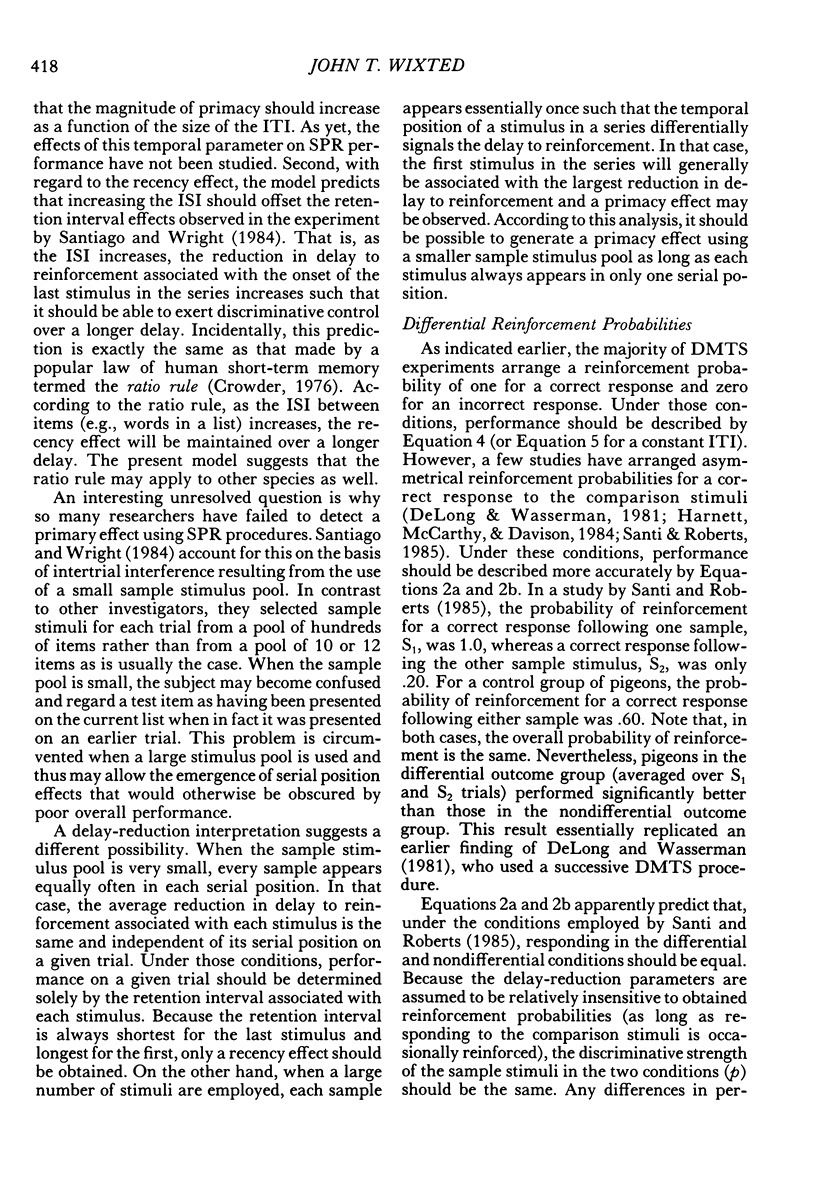

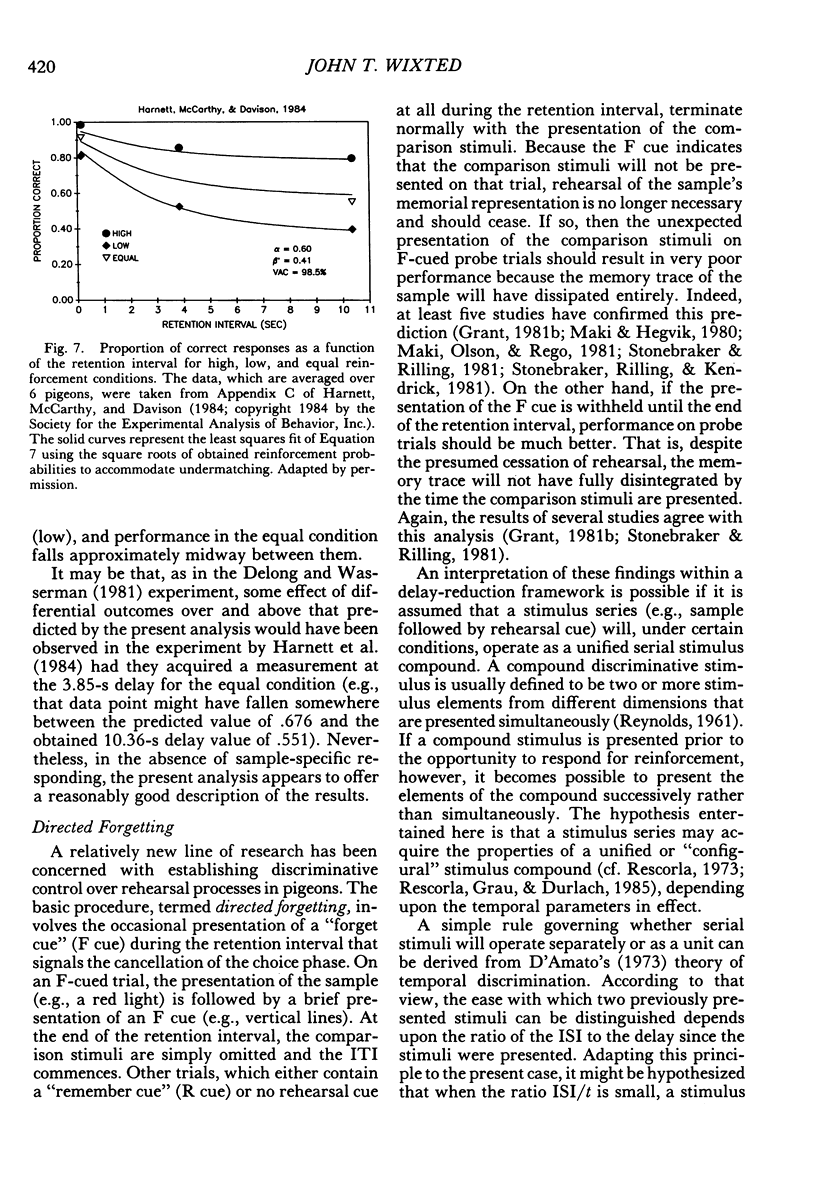
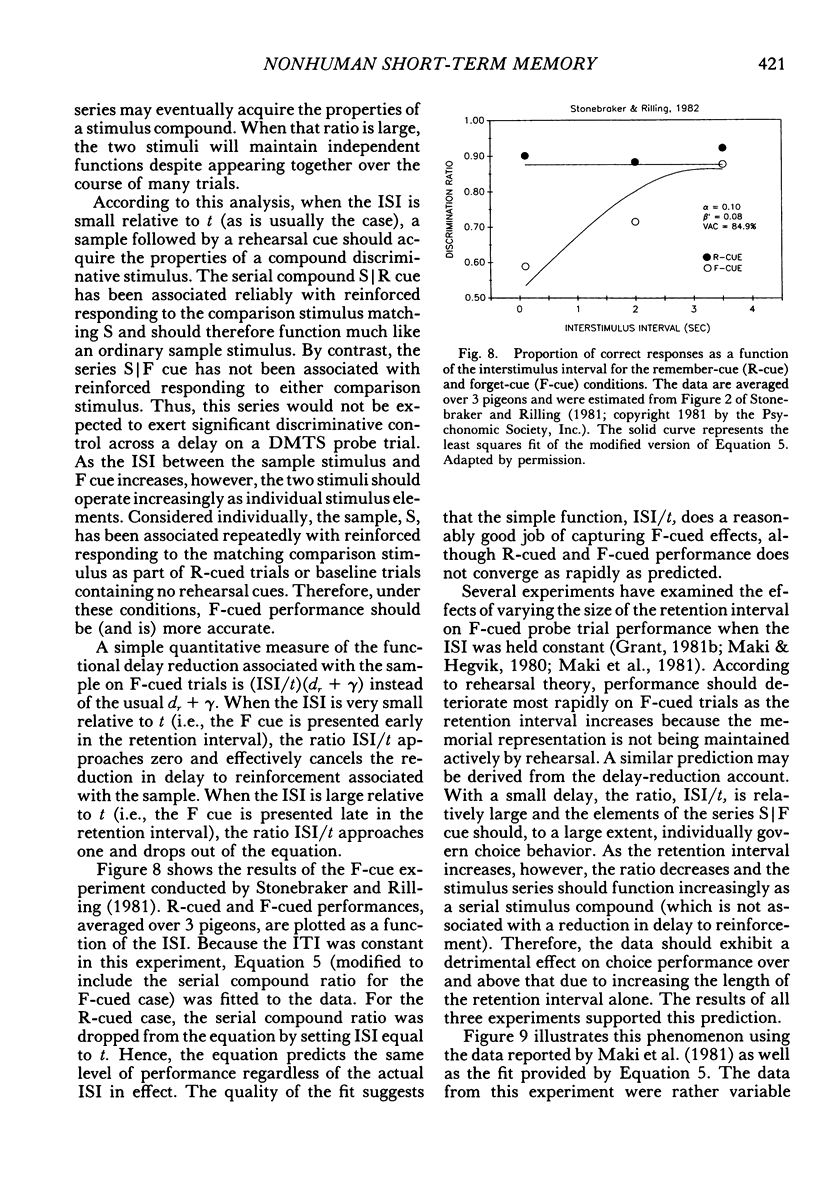

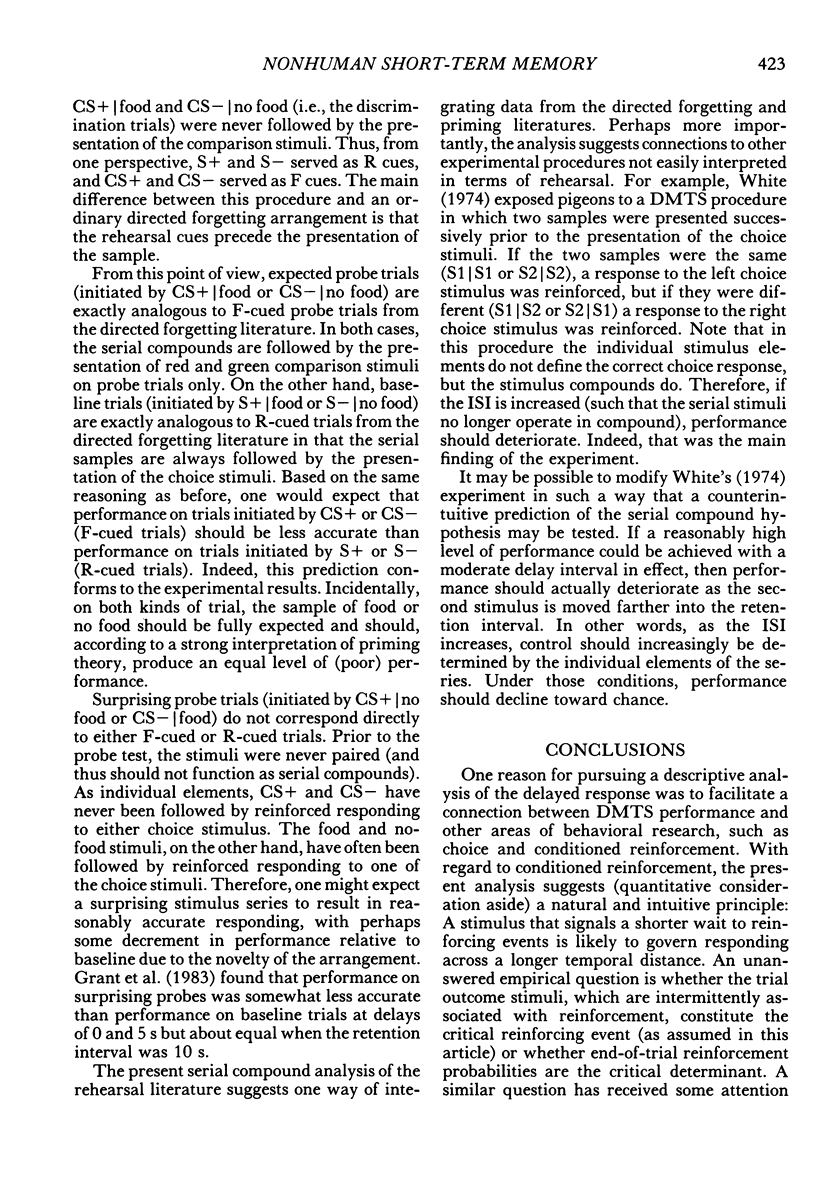

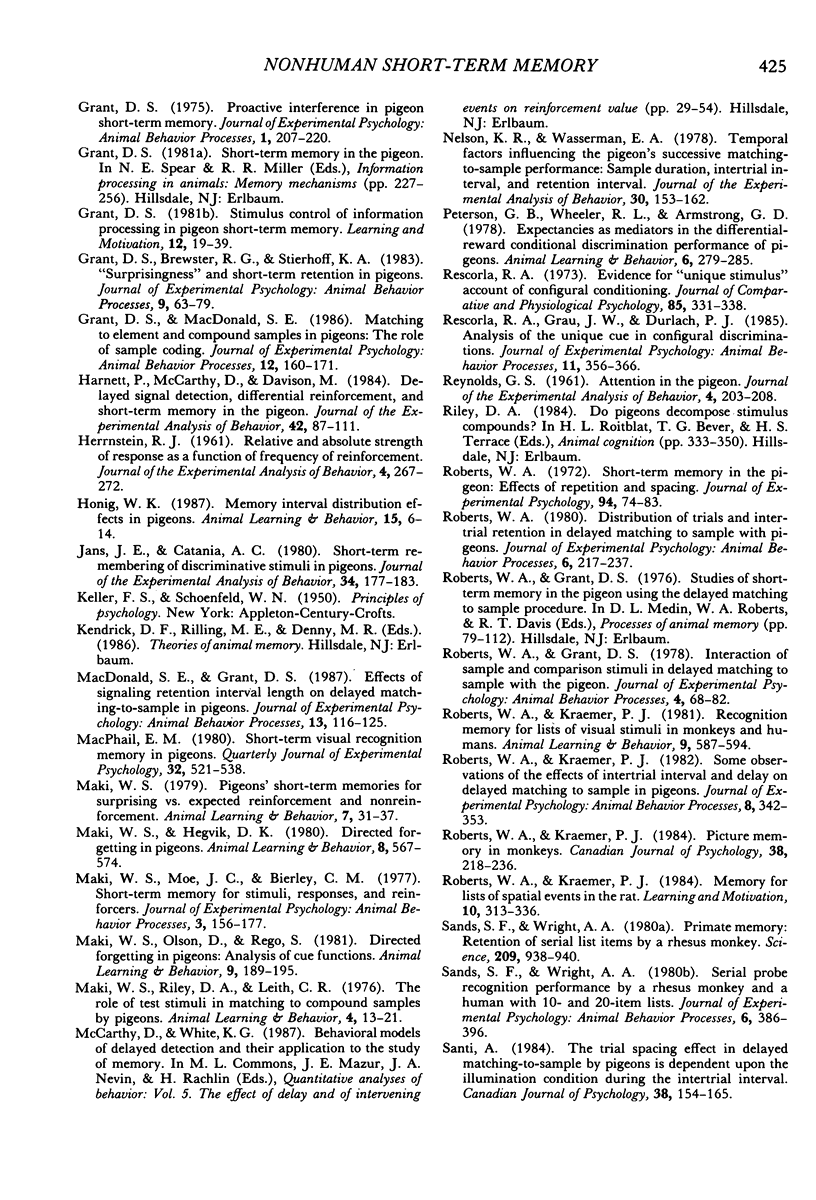
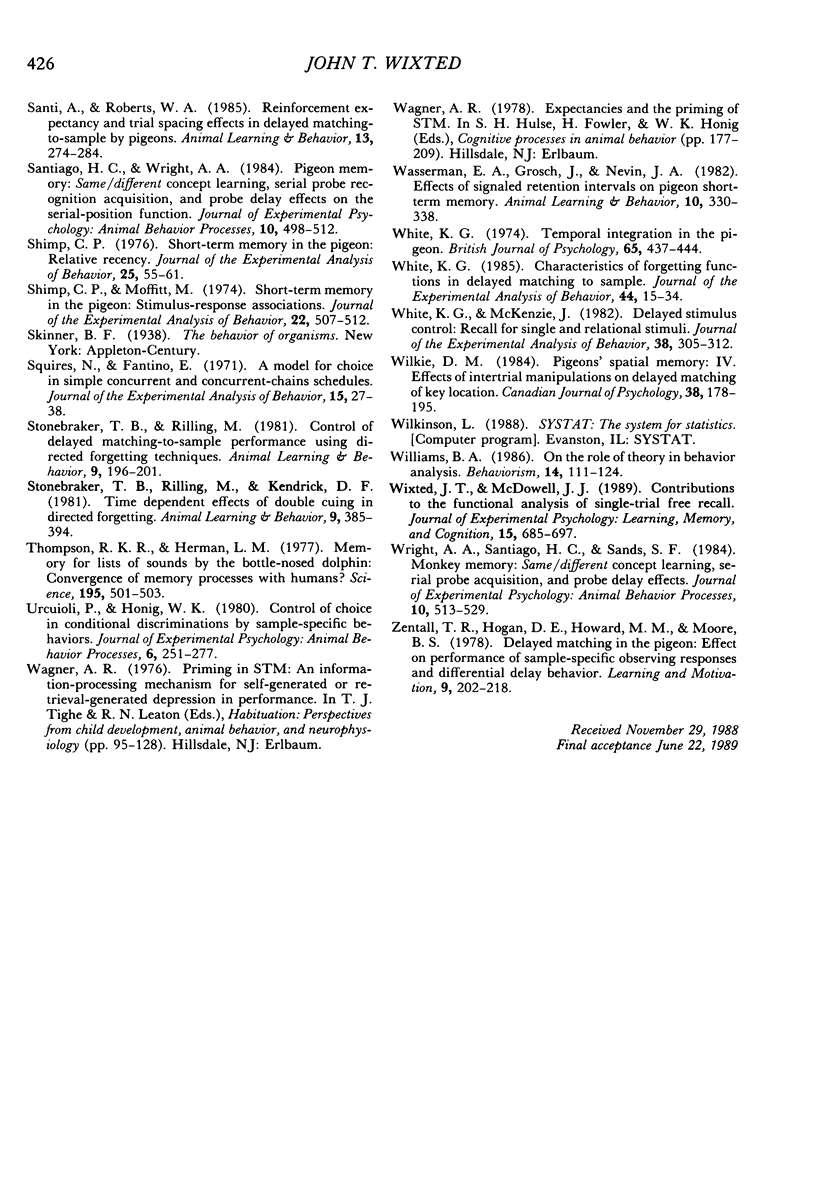
Selected References
These references are in PubMed. This may not be the complete list of references from this article.
- BLOUGH D. S. Delayed matching in the pigeon. J Exp Anal Behav. 1959 Apr;2:151–160. doi: 10.1901/jeab.1959.2-151. [DOI] [PMC free article] [PubMed] [Google Scholar]
- Branch M. N. On the role of "memory" in the analysis of behavior. J Exp Anal Behav. 1977 Sep;28(2):171–179. doi: 10.1901/jeab.1977.28-171. [DOI] [PMC free article] [PubMed] [Google Scholar]
- Brodigan D. L., Peterson G. B. Two-choice conditional discrimination performance of pigeons as a function of reward expectancy, prechoice delay, and domesticity. Anim Learn Behav. 1976 May;4(2):121–124. doi: 10.3758/bf03214021. [DOI] [PubMed] [Google Scholar]
- Buchanan J. P., Gill T. V., Braggio J. T. Serial position and clustering effects in a chimpanzee's "free recall". Mem Cognit. 1981 Nov;9(6):651–660. doi: 10.3758/bf03202360. [DOI] [PubMed] [Google Scholar]
- DINSMOOR J. A. A quantitative comparison of the discriminative and reinforcing functions of a stimulus. J Exp Psychol. 1950 Aug;40(4):458–472. doi: 10.1037/h0056266. [DOI] [PubMed] [Google Scholar]
- Davison M. C., Tustin R. D. The relation between the generalized matching law and signal-detection theory. J Exp Anal Behav. 1978 Mar;29(2):331–336. doi: 10.1901/jeab.1978.29-331. [DOI] [PMC free article] [PubMed] [Google Scholar]
- DeLong R. E., Wasserman E. A. Effects of differential reinforcement expectancies on successive matching-to-sample performance in pigeons. J Exp Psychol Anim Behav Process. 1981 Oct;7(4):394–412. [PubMed] [Google Scholar]
- Fantino E., Davison M. Choice: Some quantitative relations. J Exp Anal Behav. 1983 Jul;40(1):1–13. doi: 10.1901/jeab.1983.40-1. [DOI] [PMC free article] [PubMed] [Google Scholar]
- Gaffan D. Recognition memory after short retention intervals in fornix-transected monkeys. Q J Exp Psychol. 1977 Nov;29(4):577–588. doi: 10.1080/14640747708400633. [DOI] [PubMed] [Google Scholar]
- HERRNSTEIN R. J. Relative and absolute strength of response as a function of frequency of reinforcement. J Exp Anal Behav. 1961 Jul;4:267–272. doi: 10.1901/jeab.1961.4-267. [DOI] [PMC free article] [PubMed] [Google Scholar]
- Harnett P., McCarthy D., Davison M. Delayed signal detection, differential reinforcement, and short-term memory in the pigeon. J Exp Anal Behav. 1984 Jul;42(1):87–111. doi: 10.1901/jeab.1984.42-87. [DOI] [PMC free article] [PubMed] [Google Scholar]
- Jans J. E., Catania A. C. Short-term remembering of discriminative stimuli in pigeons. J Exp Anal Behav. 1980 Sep;34(2):177–183. doi: 10.1901/jeab.1980.34-177. [DOI] [PMC free article] [PubMed] [Google Scholar]
- Macphail E. M. Short-term visual recognition memory in pigeons. Q J Exp Psychol. 1980 Nov;32(4):521–538. doi: 10.1080/14640748008401843. [DOI] [PubMed] [Google Scholar]
- Nelson K. R., Wasserman E. A. Temporal factors influencing the pigeon's successive matching-to-sample performance: sample duration, intertrial interval, and retention interval. J Exp Anal Behav. 1978 Sep;30(2):153–162. doi: 10.1901/jeab.1978.30-153. [DOI] [PMC free article] [PubMed] [Google Scholar]
- REYNOLDS G. S. Attention in the pigeon. J Exp Anal Behav. 1961 Jul;4:203–208. doi: 10.1901/jeab.1961.4-203. [DOI] [PMC free article] [PubMed] [Google Scholar]
- Rescorla R. A., Grau J. W., Durlach P. J. Analysis of the unique cue in configural discriminations. J Exp Psychol Anim Behav Process. 1985 Jul;11(3):356–366. [PubMed] [Google Scholar]
- Roberts W. A. Distribution of trials and intertrial retention in delayed matching to sample with pigeons. J Exp Psychol Anim Behav Process. 1980 Jul;6(3):217–237. doi: 10.1037//0097-7403.6.3.217. [DOI] [PubMed] [Google Scholar]
- Roberts W. A., Kraemer P. J. Picture memory in monkeys. Can J Psychol. 1984 Jun;38(2):218–236. doi: 10.1037/h0080829. [DOI] [PubMed] [Google Scholar]
- Roberts W. A., Kraemer P. J. Some observations of the effects of intertrial interval and delay on delayed matching to sample in pigeons. J Exp Psychol Anim Behav Process. 1982 Oct;8(4):342–353. [PubMed] [Google Scholar]
- Sands S. F., Wright A. A. Primate memory: retention of serial list items by a rhesus monkey. Science. 1980 Aug 22;209(4459):938–940. doi: 10.1126/science.6773143. [DOI] [PubMed] [Google Scholar]
- Sands S. F., Wright A. A. Serial probe recognition performance by a rhesus monkey and a human with 10- and 20-item lists. J Exp Psychol Anim Behav Process. 1980 Oct;6(4):386–396. [PubMed] [Google Scholar]
- Santiago H. C., Wright A. A. Pigeon memory: same/different concept learning, serial probe recognition acquisition, and probe delay effects on the serial-position function. J Exp Psychol Anim Behav Process. 1984 Oct;10(4):498–512. [PubMed] [Google Scholar]
- Shimp C. P., Moffitt M. Short-term memory in the pigeon: stimulus-response associations. J Exp Anal Behav. 1974 Nov;22(3):507–512. doi: 10.1901/jeab.1974.22-507. [DOI] [PMC free article] [PubMed] [Google Scholar]
- Shimp C. P. Short-term memory in the pigeon: relative recency. J Exp Anal Behav. 1976 Jan;25(1):55–61. doi: 10.1901/jeab.1976.25-55. [DOI] [PMC free article] [PubMed] [Google Scholar]
- Squires N., Fantino E. A model for choice in simple concurrent and concurrent-chains schedules. J Exp Anal Behav. 1971 Jan;15(1):27–38. doi: 10.1901/jeab.1971.15-27. [DOI] [PMC free article] [PubMed] [Google Scholar]
- Thompson R. K., Herman L. M. Memory for lists of sounds by the bottle-nosed dolphin: convergence of memory processes with humans? Science. 1977 Feb 4;195(4277):501–503. doi: 10.1126/science.835012. [DOI] [PubMed] [Google Scholar]
- Urcuioli P. J., Honig W. K. Control of choice in conditional discriminations by sample-specific behaviors. J Exp Psychol Anim Behav Process. 1980 Jul;6(3):251–277. [PubMed] [Google Scholar]
- White K. G. Characteristics of forgetting functions in delayed matching to sample. J Exp Anal Behav. 1985 Jul;44(1):15–34. doi: 10.1901/jeab.1985.44-15. [DOI] [PMC free article] [PubMed] [Google Scholar]
- White K. G., McKenzie J. Delayed stimulus control: recall for single and relational stimuli. J Exp Anal Behav. 1982 Nov;38(3):305–312. doi: 10.1901/jeab.1982.38-305. [DOI] [PMC free article] [PubMed] [Google Scholar]
- Wright A. A., Santiago H. C., Sands S. F. Monkey memory: same/different concept learning, serial probe acquisition, and probe delay effects. J Exp Psychol Anim Behav Process. 1984 Oct;10(4):513–529. [PubMed] [Google Scholar]


